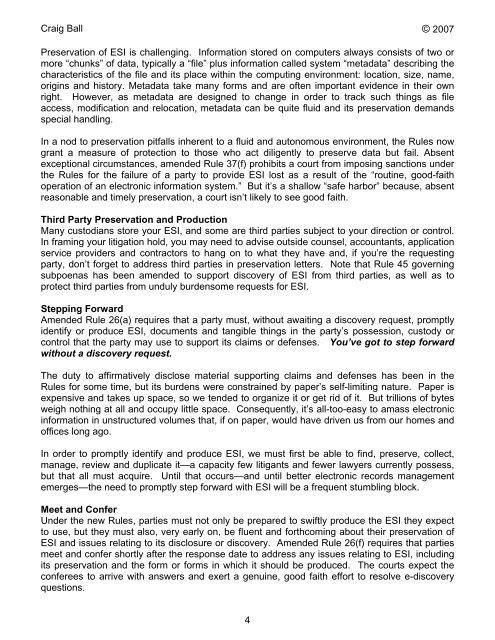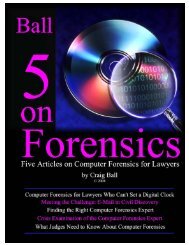Six Articles on Electronic - Craig Ball
Six Articles on Electronic - Craig Ball
Six Articles on Electronic - Craig Ball
Create successful ePaper yourself
Turn your PDF publications into a flip-book with our unique Google optimized e-Paper software.
<strong>Craig</strong> <strong>Ball</strong> © 2007<br />
Preservati<strong>on</strong> of ESI is challenging. Informati<strong>on</strong> stored <strong>on</strong> computers always c<strong>on</strong>sists of two or<br />
more “chunks” of data, typically a “file” plus informati<strong>on</strong> called system “metadata” describing the<br />
characteristics of the file and its place within the computing envir<strong>on</strong>ment: locati<strong>on</strong>, size, name,<br />
origins and history. Metadata take many forms and are often important evidence in their own<br />
right. However, as metadata are designed to change in order to track such things as file<br />
access, modificati<strong>on</strong> and relocati<strong>on</strong>, metadata can be quite fluid and its preservati<strong>on</strong> demands<br />
special handling.<br />
In a nod to preservati<strong>on</strong> pitfalls inherent to a fluid and aut<strong>on</strong>omous envir<strong>on</strong>ment, the Rules now<br />
grant a measure of protecti<strong>on</strong> to those who act diligently to preserve data but fail. Absent<br />
excepti<strong>on</strong>al circumstances, amended Rule 37(f) prohibits a court from imposing sancti<strong>on</strong>s under<br />
the Rules for the failure of a party to provide ESI lost as a result of the “routine, good-faith<br />
operati<strong>on</strong> of an electr<strong>on</strong>ic informati<strong>on</strong> system.” But it’s a shallow “safe harbor” because, absent<br />
reas<strong>on</strong>able and timely preservati<strong>on</strong>, a court isn’t likely to see good faith.<br />
Third Party Preservati<strong>on</strong> and Producti<strong>on</strong><br />
Many custodians store your ESI, and some are third parties subject to your directi<strong>on</strong> or c<strong>on</strong>trol.<br />
In framing your litigati<strong>on</strong> hold, you may need to advise outside counsel, accountants, applicati<strong>on</strong><br />
service providers and c<strong>on</strong>tractors to hang <strong>on</strong> to what they have and, if you’re the requesting<br />
party, d<strong>on</strong>’t forget to address third parties in preservati<strong>on</strong> letters. Note that Rule 45 governing<br />
subpoenas has been amended to support discovery of ESI from third parties, as well as to<br />
protect third parties from unduly burdensome requests for ESI.<br />
Stepping Forward<br />
Amended Rule 26(a) requires that a party must, without awaiting a discovery request, promptly<br />
identify or produce ESI, documents and tangible things in the party’s possessi<strong>on</strong>, custody or<br />
c<strong>on</strong>trol that the party may use to support its claims or defenses. You’ve got to step forward<br />
without a discovery request.<br />
The duty to affirmatively disclose material supporting claims and defenses has been in the<br />
Rules for some time, but its burdens were c<strong>on</strong>strained by paper’s self-limiting nature. Paper is<br />
expensive and takes up space, so we tended to organize it or get rid of it. But trilli<strong>on</strong>s of bytes<br />
weigh nothing at all and occupy little space. C<strong>on</strong>sequently, it’s all-too-easy to amass electr<strong>on</strong>ic<br />
informati<strong>on</strong> in unstructured volumes that, if <strong>on</strong> paper, would have driven us from our homes and<br />
offices l<strong>on</strong>g ago.<br />
In order to promptly identify and produce ESI, we must first be able to find, preserve, collect,<br />
manage, review and duplicate it—a capacity few litigants and fewer lawyers currently possess,<br />
but that all must acquire. Until that occurs—and until better electr<strong>on</strong>ic records management<br />
emerges—the need to promptly step forward with ESI will be a frequent stumbling block.<br />
Meet and C<strong>on</strong>fer<br />
Under the new Rules, parties must not <strong>on</strong>ly be prepared to swiftly produce the ESI they expect<br />
to use, but they must also, very early <strong>on</strong>, be fluent and forthcoming about their preservati<strong>on</strong> of<br />
ESI and issues relating to its disclosure or discovery. Amended Rule 26(f) requires that parties<br />
meet and c<strong>on</strong>fer shortly after the resp<strong>on</strong>se date to address any issues relating to ESI, including<br />
its preservati<strong>on</strong> and the form or forms in which it should be produced. The courts expect the<br />
c<strong>on</strong>ferees to arrive with answers and exert a genuine, good faith effort to resolve e-discovery<br />
questi<strong>on</strong>s.<br />
4













